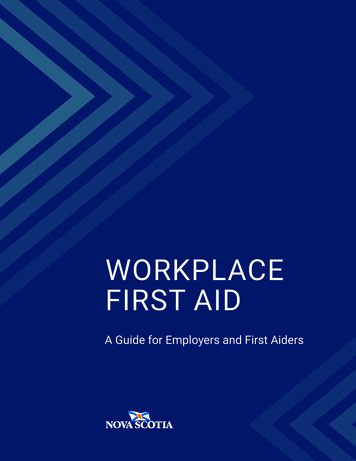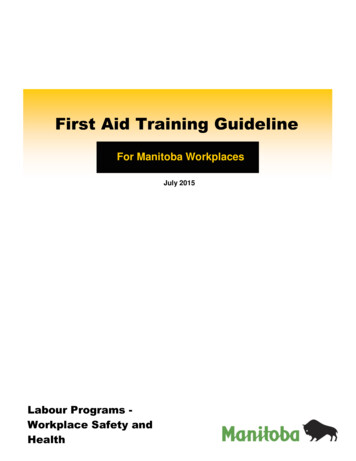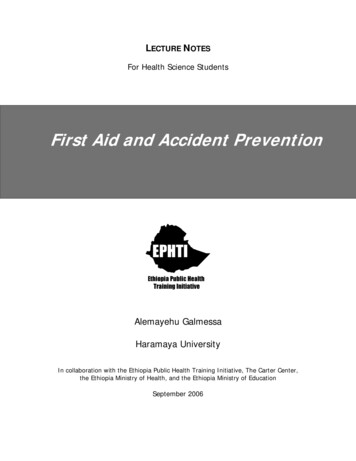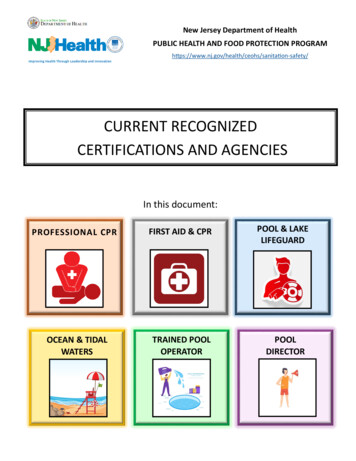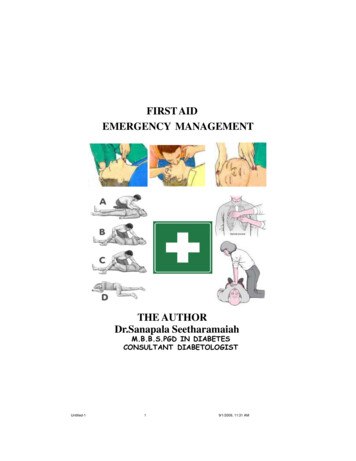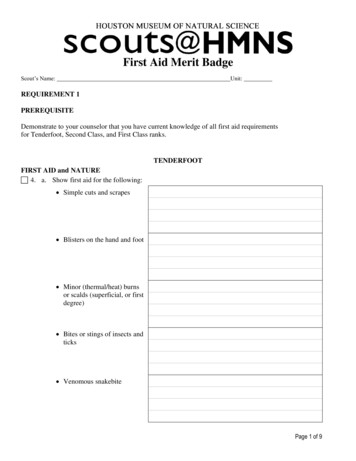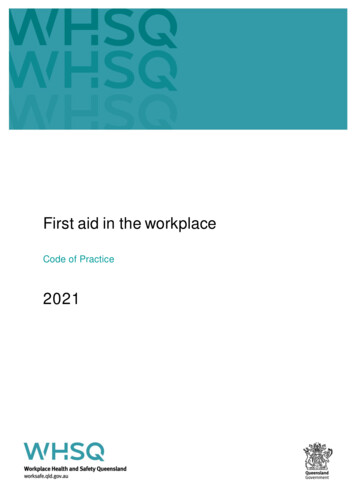
Transcription
First aid in the workplaceCode of Practice2021
PN12655ISBN Creative CommonsThis copyright work is licensed under a Creative Commons Attribution-Noncommercial 4.0International licence. To view a copy of this licence, visit creativecommons.org/licenses. In essence,you are f ree to copy, communicate and adapt the work f or non-commercial purposes, as long as youattribute the work to Saf e Work Australia and abide by the other licence terms.
ContentsForeword. 41. Introduction . 51.1Who has health and safety duties in relation to first aid? . 51.2What is required in providing first aid? . 62. How to determine first aid requirements for your workplace . 92.1The nature of the work and workplace hazards . 92.2Size and location of the workplace. 102.3The number and composition of workers and others at the workplace . 113. First aid equipment, facilities and training . 123.1First aid kits . 123.2First aid signs. 133.3Other first aid equipment . 143.4First aid facilities . 153.5First aiders . 163.6First aid procedures . 183.7Providing first aid information . 203.8Reviewing your first aid requirements . 20Appendix A–Glossary. 22Appendix B—First aid and the risk management process . 24Appendix C – Summary of recommended first aid requirements . 25Appendix D—Example of a first aid assessment. 26Nature of the work being carried out and the nature of the hazards at the workplace. 27Appendix E—Example of contents for first aid kits . 29Outdoor module . 31Remote module. 31Burn module . 31Appendix F—Standard precautions for infection control. 32Providing first aid safely . 32Contaminated items . 32Cleaning spills . 33First aid in the workplace Code of Practice 2021Page 3 of 33
ForewordThis Code of Practice on first aid in the workplace is an approved code of practice undersection 274 of the Work Health and Safety Act 2011 (the WHS Act).An approved code of practice is a practical guide to achieving the standards of health, safetyand welfare required under the WHS Act and the Work Health and Safety Regulation 2011(the WHS Regulation).Under section 26A of the WHS Act duty holders must comply with an approved codeof practice or follow another method, such as a technical or industry standard, if itprovides an equivalent or higher standard of work health and safety than the standardrequired in this code.A code of practice applies to anyone who has a duty of care in the circumstances describedin the code. In most cases, following an approved code of practice would achievecompliance with the health and safety duties in the WHS Act, in relation to the subject matterof the code. Like regulations, codes of practice deal with particular issues and do not coverall hazards or risks that may arise. The health and safety duties require duty holders toconsider all risks associated with work, not only those for which regulations and codes ofpractice exist.Codes of practice are admissible in court proceedings under the WHS Act and WHSRegulation. Courts may regard a code of practice as evidence of what is known about ahazard, risk or control and may rely on the code in determining what is reasonablypracticable in the circumstances to which the code relates.An inspector may refer to an approved code of practice when issuing an improvement orprohibition notice. This may include issuing an improvement notice for failure to comply witha code of practice where equivalent or higher standards of work health and safety have notbeen demonstrated.Scope and applicationThis code is intended to be read by a person conducting a business or undertaking (PCBU).It provides practical guidance to PCBUs on how to effectively provide first aid in theworkplace. It includes information on first aid kits, procedures, facilities and training forfirst aiders.This code may be a useful reference for other persons interested in the duties under theWHS Act and WHS Regulation.This Code applies to all types of work and all workplaces covered by the WHS Act.How to use this Code of PracticeThis code includes references to legal requirements under the WHS Act and WHSRegulation. These are included for convenience only and should not be relied on in place ofthe full text of the WHS Act or WHS Regulation. The words ‘must’, ‘requires’ or ‘mandatory’indicate a legal requirement exists that must be complied with.The word ‘should’ is used in this Code to indicate a recommended course of action, while‘may’ is used to indicate an optional course of action.First aid in the workplace Code of Practice 2021Page 4 of 33
1. IntroductionProviding immediate and effective first aid to workers or others who have been injured orbecome ill at the workplace may reduce the severity of the injury or illness. In some cases itcould mean the difference between life and death.1.1 Who has health and safety duties in relation to firstaid?Duty holders who have a role in first aid include: persons conducting a business or undertaking (PCBUs) designers, manufacturers, importers, suppliers and installers of plant, substances orstructures officers.Workers and other persons at the workplace also have duties under the WHS Act, such asthe duty to take reasonable care for their own health and safety at the workplace.A person can have more than one duty and more than one person can have the same dutyat the same time.Early consultation and identification of risks can allow for more options to eliminate orminimise risks and reduce the associated costs.Person conducting a business or undertaking (PCBU)PCBUs have the primary duty under the WHS Act. In general terms this duty requiresPCBUs to ensure, so far as is reasonably practicable, that workers and other persons arenot exposed to health and safety risks arising from the business or undertaking.WHS Regulation section 42Duty to provide first aidA PCBU must ensure: provision of first aid equipment each worker at the workplace has access to the equipment access to facilities for administering first aid an adequate number of workers are trained to administer first aid, or workers haveaccess to an adequate number of other people who have been trained to administer firstaid (see section 3.5 of this Code).A PCBU may not need to provide first aid equipment or facilities if these are alreadyprovided by another duty holder at the workplace and they are adequate and easilyaccessible at the times the workers carry out work.Designers, manufacturers, importers and suppliers of plant, substancesor structuresWHS Act Part 2 Division 3Further duties of persons conducting businesses or undertakingsFirst aid in the workplace Code of Practice 2021Page 5 of 33
Designers, manufacturers, importers and suppliers of plant or substances or structures usedin the workplace must ensure, so far as is reasonably practicable, the plant, substance orstructure they design, manufacture, import or supply is without risks to health and safety.This duty includes carrying out testing and analysis as well as providing specific informationabout the plant or substance.To assist in meeting these duties, the WHS Regulation require: manufacturers to consult with designers of the plant importers to consult with designers and manufacturers of plant the person who commissions construction work to consult with the designer ofthe structure.OfficersWHS Act section 27Duty of officersOfficers, for example company directors, have a duty to exercise due diligence to ensure thePCBU complies with the WHS Act and WHS Regulation. This includes taking reasonablesteps to ensure the business or undertaking has and uses appropriate processes f orcomplying with the duty to provide first aid.WorkersWHS Act section 28Duties of workersWorkers have a duty to take reasonable care for their own health and safety and to notadversely affect the health and safety of other persons. Workers must comply withreasonable instructions, as far as they are reasonably able, and cooperate with reasonablehealth and safety policies or procedures, that have been notified to workers, for exampleprocedures for first aid and for reporting injuries and illnesses.Other persons in the workplaceWHS Act section 29Duties of other persons at the workplaceOther persons at the workplace, like visitors, must take reasonable care for their own healthand safety and must take care not to adversely affect other people’s health and safety. Theymust comply, so far as they are reasonably able, with reasonable instructions given by thePCBU to allow that person to comply with the WHS Act.1.2 What is required in providing first aid?First aid requirements will vary from one workplace to the next, depending on the nature ofthe work, the types of hazards, the workplace size and location, as well as the number ofpeople at the workplace. These factors must be taken into account when deciding what firstaid arrangements are provided.This Code provides information on using a risk management approach to tailor first aid tosuit the circumstances of your workplace, while also providing guidance on the number ofFirst aid in the workplace Code of Practice 2021Page 6 of 33
first aid kits, their contents and the number of trained first aiders appropriate for some typesof workplaces.The risk management approach involves the following four steps, summarised inAppendix B: identifying hazards that could result in work-related injury or illness assessing the type, severity and likelihood of injuries and illness providing the appropriate first aid equipment, facilities and training reviewing your first aid requirements on a regular basis or as circumstances change.Guidance on the general risk management process is available in the How to manage workhealth and safety risks Code of Practice.Consulting workersWHS Act section 47Duty to consult workersA PCBU must consult, so far as is reasonably practicable, with workers who carry out workfor the business or undertaking and who are (or are likely to be) directly affected by a healthand safety matter.This duty to consult is based on the recognition that worker input and participation improvesdecision-making about health and safety matters.The broad definition of a ‘worker’ under the WHS Act means a PCBU must consult, so far asis reasonably practicable, with contractors and subcontractors and their employees, on-hireworkers, outworkers, apprentices, trainees, work experience students, volunteers and otherpeople who are working for the PCBU and who are, or are likely to be, directly affected by ahealth and safety matter.Workers are entitled to take part in consultations and to be represented in consultations by ahealth and safety representative who has been elected to represent their work group.WHS Act section 48Nature of consultationIf the workers are represented by a health and safety representative, the consultation mustinvolve that representative.You must consult your workers when making decisions about what equipment and facilitiesare needed for administering first aid. Consultation should include: the number, location and contents of first aid kits and other equipment the type of first aid facilities that may be needed first aid procedures the number of first aiders.First aid in the workplace Code of Practice 2021Page 7 of 33
Consulting, cooperating and coordinating activities with other dutyholdersWHS Act section 46Duty to consult with other duty holdersThe WHS Act requires a PCBU to consult, cooperate and coordinate activities with all otherpersons who have a work health or safety duty in relation to the same matter, so far as isreasonably practicable.There is often more than one business or undertaking with responsibility for the same healthand safety matters, either because they are involved in the same activities or share thesame workplace.In these situations, each duty holder should exchange information to find out who is doingwhat and work together in a cooperative and coordinated way.For example, if a PCBU provides labour hire workers as part of its business, both it and thehost business have a duty of care. In these situations, the duty holder must discuss thehazards and risks associated with the work and ensure the host business has appropriatefirst aid arrangements the workers can access.If the workplace is shared with other businesses that have first aiders, the PCBU may beable to ensure its workers have access to these first aiders instead of training their ownworkers. In these circumstances, it will be necessary to: consult the other business operators to work out what first aid arrangements are needed cooperate with each other in sharing first aid equipment and facilities coordinate access to the first aiders.Further guidance on consultation is available in the Work health and safety consultation,cooperation and coordination Code of Practice.First aid in the workplace Code of Practice 2021Page 8 of 33
2. How to determine first aid requirements foryour workplaceWHS Regulation section 42(3)Duty to provide first aidTo meet your duty as a person conducting a business or undertaking (PCBU) to provideaccess to first aid equipment, facilities and trained first aiders you must have regard to allrelevant matters, including the following: the nature of the work being carried out at the workplace the nature of the hazards at the workplace the size and location of the workplace the number and composition of the workers and other persons at the workplace.Appendix C summarises the requirements for first aid kits, first aiders and first aid rooms.2.1 The nature of the work and workplace hazardsCertain work environments have greater risk of injury and illness due to the nature of workbeing carried out and the nature of the hazards at the workplace. For example, workers infactories, motor vehicle workshops and forestry operations are at greater risk of injuryrequiring immediate medical treatment than workers in offices or libraries. These workplaceswill therefore require different first aid arrangements.Table 1 Injuries associated with common workplace hazards that may require first aidHazardPotential harmManual tasksOverexertion can cause muscular strain.Working at height oron uneven orslippery surfacesSlips, trips and f alls can cause f ractures, bruises, lacerations, dislocations,concussion.ElectricityPotential ignition source—could cause injuries f rom f ire. Exposure to liveelectrical wires can cause shock, burns and cardiac arrest.Machinery andequipmentBeing hit by moving vehicles, or being caught by moving parts ofmachinery can cause f ractures, amputation, bruises, lacerations,dislocations.HazardouschemicalsToxic or corrosive chemicals may be inhaled or may contact skin or eyescausing poisoning, chemical burns, irritation.Flammable chemicals could result in injuries f rom f ire or explosion.ExtremetemperaturesHot surf aces and materials can cause burns.Working in extreme heat can cause heat-related illness. It can alsoincrease risks by reducing concentration and increasing f atigue andchemical uptake into the body.Exposure to extreme cold can cause hypothermia and f rostbite.RadiationWelding arc f lashes, ionising radiation and lasers can cause burns.Ultraviolet (UV) radiation f rom the sun can cause sunburn, skin cancersand eye damage.First aid in the workplace Code of Practice 2021Page 9 of 33
HazardPotential harmViolenceBehaviours including intimidation and physical assault can cause bothphysical and psychological injuries.BiologicalInf ection, allergic reactionsAnimalsBites, stings, kicks, crush injuries, scratchesRecords of injuries, illnesses, ‘near miss’ incidents and other information will be useful whenmaking decisions about first aid requirements.You should check the safety data sheets (SDS) for hazardous chemicals handled, used orstored at your workplace. The SDS provides information about the chemical, possible healtheffects, controls that may be used to reduce exposure and first aid requirements.Under the WHS Regulation suppliers of hazardous chemicals must provide the current SDSto a person at the workplace if the person asks for it.2.2 Size and location of the workplaceIn relation to the size and location of the workplace, you should take into account: the distance between different work areas, and the response times for emergency services.First aid equipment and facilities should be located at convenient points and in areas wherethere is a higher risk of an injury or illness occurring.A large workplace may require first aid to be available in more than one location if: work is being carried out a long distance from emergency services workers are dispersed over a wide area access to a part of the workplace is difficult, or the workplace has more than one floor level.Where there are separate work areas, for example multiple buildings on a site or multiplefloors in an office building, it may be appropriate to locate first aid facilities centrally andprovide first aid kits in each work area. This may include portable first aid kits in motorvehicles and other separate work areas.The distance of the workplace from ambulance services, hospital and medical centresshould be taken into account when determining your first aid requirements. For example, iflife-threatening injuries or illnesses could occur and timely access to emergency servicescannot be assured, a person trained in more advanced first aid techniques, for exampleproviding oxygen, should be considered.Extra first aid considerations may be necessary for workers in remote or isolated areas. Forexample, where access is difficult due to travel time, poor roads or weather conditions,arrangements should include aerial evacuation.In minimising the risks to health and safety associated with remote or isolated work, youmust provide a safe system of work including effective communication with the worker. Thiswill assist in enabling an immediate response in an emergency. Further guidance aboutworking in remote or isolated areas is available in the Managing the work environment andfacilities Code of Practice.First aid in the workplace Code of Practice 2021Page 10 of 33
2.3 The number and composition of workers andothers at the workplaceWhen considering the size of your workforce, you should include contractors, subcontractorsand volunteers you engage. This may mean the size of your workforce may vary over time.For the purposes of deciding who requires access to first aid, you should consider themaximum number of workers you may engage at one time. Generally, a larger workforcerequires more first aid resources.You should also consider: the particular needs of workers who have a disability or a known health concern forexample asthma or allergies, and others at your workplace who are not your workers, for example: students in schools and education facilities clients under care members of the public in places involving exercise, leisure and entertainment forexample gyms, cinemas, fairgrounds and shopping centres.Appendix D provides an example of how to determine first aid requirements.First aid in the workplace Code of Practice 2021Page 11 of 33
3. First aid equipment, facilities and trainingThe information provided in this chapter may be used as a guide to determine the first aidequipment, facilities, first aiders and procedures that you as a person conducting a businessor undertaking (PCBU), need to provide in various workplaces.First aid equipment, facilities and first aiders must be accessible to workers whenever theywork including those working night shifts or overtime.Appendix C summarises the requirements for first aiders, first aid kits and first aid rooms.3.1 First aid kitsAll workers must be able to access a first aid kit. This will require at least one first aid kit tobe provided at their workplace.ContentsThe first aid kit should provide basic equipment for administering first aid for injuriesincluding: cuts, scratches, punctures, grazes and splinters muscular sprains and strains minor burns amputations and/or major bleeding wounds broken bones eye injuries shock.The contents of first aid kits should be based on a risk assessment. For example, there maybe higher risk of eye injuries and a need for more eye pads in a workplace in which workinvolves machinery or chemicals. For example, where: chemical liquids or powders are handled in open containers spraying, hosing or abrasive blasting operations are carried out there is a possibility of flying particles causing eye injuries there is a risk of splashing or spraying of infectious materials, or welding, cutting or machining operations are carried out.Extra equipment may be needed in remote workplaces, for example for serious burns,breathing difficulties or allergic reactions.The recommended contents of a typical first aid kit and information on extra equipment isprovided in Appendix E.Design of kitsFirst aid kits can be any size, shape or type to suit your workplace, but each kit should: be large enough to contain the necessary items be immediately identifiable with a white cross on green background prominentlydisplayed on the outside contain a list of the contents for that kit be made of material that will protect the contents from dust, moisture and contamination.First aid in the workplace Code of Practice 2021Page 12 of 33
LocationIn the event of a serious injury or illness, quick access to the kit is vital. First aid kits shouldbe kept in a prominent, accessible location where they can be retrieved quickly. All workersmust have access to first aid equipment including in security-controlled workplaces.First aid kits should be located close to areas where there is a higher risk of injury or illness.For example, a school with a science laboratory or carpentry workshop should have first aidkits located in these areas. If the workplace occupies several floors in a multistorey building,at least one kit should be located on every second floor. Emergency floor plans displayed inthe workplace should include the location of first aid kits.A portable first aid kit should be provided in the vehicles of mobile workers if that is theirworkplace, for example couriers, taxi drivers, sales representatives, bus drivers andinspectors. These kits should be safely located so as not to become a projectile in acollision.Restocking and maintaining kitsA person in the workplace, usually a first aid officer, should be nominated to maintain thefirst aid kit and should: monitor usage of the first aid kit and ensure items used are replaced as soon aspracticable after use carry out regular checks, after each use or, if the kit is not used, at least once every 12months, to ensure the kit contains a complete set of the required items. An inventory listin the kit should be signed and dated after each check ensure items are in working order, have not deteriorated, are within their expiry datesand sterile products are sealed and have not been tampered with.3.2 First aid signsDisplaying well-recognised first aid signs will assist in easily locating first aid equipment andfacilities (see Figure 1 below). Further information on the design and use of signs is availablein AS 1319: Safety Signs for the Occupational Environment.First aid in the workplace Code of Practice 2021Page 13 of 33
Figure 1 First aid signs3.3 Other first aid equipmentIn addition to first aid kits, you should consider whether other first aid equipment isnecessary to treat the injuries or illnesses that could occur as a result of a hazard atyour workplace.Automated external defibrillatorsProviding an automated external defibrillator (AED) can reduce the risk of fatality fromcardiac arrest. While cardiopulmonary resuscitation (CPR) can prolong life, defibrillation isthe only way to restore a heart with a fatal heart rhythm back to a normal heart rhythm.You should consider providing an AED if there is a risk to workers at your workplace fromelectrocution, if there would be a delay in ambulance services arriving at the workplace, orwhere there are large numbers of members of the public.AEDs are designed to be used by trained or untrained people. They provide audible step-bystep instruction on how to use them and how to perform CPR. They can detect whether theyhave been applied correctly and will instruct whether defibrillation is appropriate. Most AEDsFirst aid in the workplace Code of Practice 2021Page 14 of 33
will also keep records once they are activated including some vital signs and whether shockshave been recommended and administered.They should be located in an area clearly visible, accessible and not exposed to extremetemperatures. They should be clearly signed and maintained according to themanufacturer’s specifications.Eye wash and shower equipmentEmergency eye wash equipment should be provided where there is a risk of hazardouschemicals or infectious substances causing eye injuries.Immediate access should be provided to emergency shower equipment in workplaces wherethere is a risk of: exposure to hazardous chemicals resulting in skin absorption or contamination frominfectious substances, or serious burns to a large area of the face or body, including chemical or electrical burns orburns that are deep, in sensitive areas or larger than a 20 cent piece.Shower facilities can consist of: a deluge facility a permanently rigged hand-held shower hose, or a portable plastic or rubber shower hose designed to be easily attached to a tap spout—for small, relatively low risk workplaces where a fixed deluge facility would not bereasonably practicable, but the risk of serious burns is still foreseeable, for example afish and chip shop.Eye wash and shower equipment may be permanently fixed or portable, depending onthe workplace. Portable, self-contained eye wash or shower units have their own flushingfluid to flush chemicals, foreign objects or substances from the eyes or body. They need tobe refilled or replaced after use.Further guidance is available in AS 4775: Emergency eyewash and shower equipment.3.4 First aid facilitiesA risk assessment will help determine the type of first aid facilities needed. For example, aclean, quiet area within the workplace affording privacy to an injured or ill person may besuitable and practicable for some workplaces.Access to a telephone for contacting emergency services or an emergency call systemshould be provided as part of first aid facilities.First aid roomsA first aid room should be established at the workplace if a risk assessment indicates itwould be difficult to administer first aid unless a first aid room is provided.For example, workplaces where there is a higher risk of serious injury or illness occurring,requiring immediate first aid and possible further treatment by an emergency service, maybenefit from having access to a dedicated first aid room.A first aid room is recommended for: low risk workplaces with 200 workers or more, or high risk workplaces with 100 workers or more.First aid in the workplace Code of Practice 2021Page 15 of 33
The contents of a first aid room should suit the hazards specific to the workplace. Thelocation and size of the room should allow easy access and movement of injured people,noting they may need to be supported or moved by stretcher or wheelchair.The following items should be provided in the room: a first aid kit appropriate for the workplace hygienic hand cleanser and disposable paper towels an examination couch with waterproof surface and disposable sheets a cupboard for storage a container with disposable lining for soiled waste a container for the safe disposal of sharps a b
First aid in the workplace Code of Practice 2021 Page 4 of 33 Foreword This Code of Practice on first aid in the workplace is an approved code of practice under section 274 of the Work Health and Safety Act 2011 (the WHS Act). An approved code of practice is a practical guide to achieving the standards of health, safety


